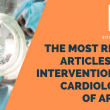Drug coated balloons (DCB) emerged as an innovative treatment approximately 10 years ago. Since then, numerous randomized studies have shown their effectiveness and benefit in femoropopliteal territory, and even though the use of paclitaxel coated balloons has been called into question, a retrospective study including 168,553 patients was able to show paclitaxel coated balloons were...
Fellow’s Corner Invitation. Submit your case and let’s keep learning together
Dear LATAM Fellows: We would like to tell you the Fellow’s Corner is coming back this year (FC). This is why we invite you once again to send us your cases on coronary artery, valve, peripheral and structural disease you might want to share with the entire SOLACI and ProEducar communities. As always, we plan to learn from each...
Are There Differences Between Women and Men After a Percutaneous Intervention?
Prior research has shown that women with coronary artery disease who undergo percutaneous revascularization present more comorbidities, require less aggressive treatments, have greater long-term morbidity rates and worst functional status and/or post-procedure angina. This study used data from the CPORT-E trial (Cardiovascular Patient Outcomes Research Team Non primary Percutaneous Coronary Intervention) to assess baseline differences...
Complete Revascularization after Pharmacoinvasive Strategy
Patients initially receiving pharmacoinvasive strategy for ST elevation myocardial infarction (STEMI) also presenting multivessel disease consistently benefit from complete revascularization. This benefit is similar to that of primary PCI. The COMPLETE showed that staged non-culprit lesion percutaneous coronary intervention (PCI) reduced major cardiovascular events in STEMI patients with multivessel coronary artery disease. This benefit was...
The most read scientific articles on interventional cardiology of april
01- Post MI Betablockers for Good? Patients receiving optimal medical treatment after MI do not seem to benefit from betablockers in the long term, provided they do not present cardiac failure or systolic function deterioration. Read more HERE 02- Thrombocytopenia and Thrombosis May Be Linked to AstraZeneca Vaccine, Analysis Reports This is one of the...
The Most Read Articles of September in Interventional Cardiology
01- ESC 2020 | New European Guidelines on Non-ST-Segment Elevation Acute Coronary Syndromes: What’s New? The new European guidelines on NON-ST-segment elevation acute coronary syndromes (NSTE ACS) were presented virtually during the European Society of Cardiology 2020 Congress (ESC 2020) and published in Eur Heart J. Read more HERE 02- Ticagrelor to Improve Venous Graft Patency Saphenous...
The Fellow’s Corner | 1st Clinical Case: All That Glitters Is Not Gold
We present the first clinical case in the section “The Fellow’s Corner”, aimed at fellows in Latin America who wish to learn and always be up to date in interventional cardiology. Leave your thoughts in the comment section of this article and join the conversation! Case Authors: Jair Suriano Martins (ARG), Leonardo Ripa (ARG). Moderator:...
Two-Stent Strategy is Safer in True Bifurcation Lesions
Courtesy of Dr. Carlos Fava. DES have improved PCI outcomes, but one of its biggest challenges continues to be bifurcations (especially when we have to use two stents, since it’s been associated to higher restenosis and stent thrombosis rates). Left main coronary artery true bifurcation lesions are the ones that generate the greatest challenge and...
The Most Read Scientific Articles of June in solaci.org
01- The FDA Approves Ticagrelor for Primary Prevention in High Risk Patients The FDA has approved the indication of ticagrelor as primary prevention in high risk CAD patients with no history of MI or stroke. Read also HERE 02- Estimating the Risk of Infection for Healthcare Personnel Roughly one out of every 100 healthcare workers at...
The Most Read Scientific Articles of May in Interventional Cardiology
01- Management of Infarction During the COVID-19 Pandemic Patients with cardiovascular disease infected with COVID-19 are at a particular risk for morbidity and mortality. In any case, it should be noted that most patients requiring cardiovascular care due to ischemic heart disease, peripheral vascular disease, or structural heart disease are not infected. Read more HERE...









